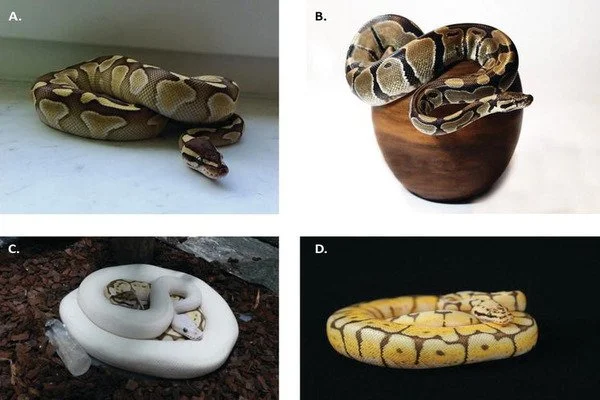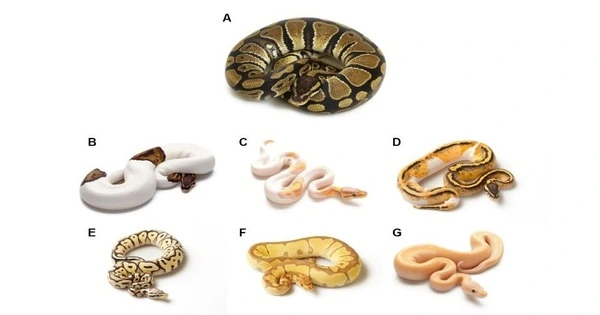Recent research has shown that reptile coloration serves a wide range of functions beyond camouflage, including social signaling, thermoregulation, and protection from UV radiation. Additionally, many reptiles can rapidly change color in response to environmental or social cues, indicating a higher degree of complexity and flexibility in their coloration than previously thought.
Snakes and mice do not have the same appearance. However, much of what we know about skin coloration and patterning in vertebrates, including snakes, is based on laboratory mice. However, mice cannot tell us everything about other vertebrates because they do not share all of the same types of color-producing cells, known as chromatophores.
To better understand the genetic basis of coloration in vertebrates, a research team used a variety of techniques (whole gene sequencing, gene editing, and electron microscopy) to examine color variations and patterning in the skin shed by captive-bred ball pythons. They were able to identify a particular gene that plays a crucial role in reptile pigmentation generally and more specifically in a classic color variant found across vertebrates and distinguished by blotches of white, the piebald.
Snakes and mice do not have the same appearance. However, much of what we know about skin coloration and patterning in vertebrates, including snakes, is based on laboratory mice. However, mice cannot tell us everything about other vertebrates because they do not share all of the same types of color-producing cells, known as chromatophores. Iridophores, for example, are a type of chromatophore found in snakes that can generate iridescent colors by reflecting light.
Our research advances knowledge of the genetics of vertebrate coloration in general, and particularly of the development of iridescent cells, which haven’t received as much attention as other color pathways.
Alan Garcia-Elfring
To gain a better understanding of the genetic basis of coloration in vertebrates, a team led by McGill University used a variety of techniques (whole gene sequencing, gene editing, and electron microscopy) to examine color variations and patterns in the skin shed by captive-bred ball pythons. They were able to identify a particular gene (tfec) that plays a crucial role in reptile pigmentation generally and more specifically in a classic color variant found across vertebrates and distinguished by blotches of white, the piebald.
Crowdsourcing biological data with the help of snake breeders
The sale of captive-bred reptiles is a $1.4 billion industry within the U.S. alone. Over 4.5 million American households keep reptiles, and close to one in five of these are snakes bred in captivity. Due to the spectacular color variations produced through captive breeding, an individual ball python (Python regius – originally found in West and Central Africa) can sell for tens of thousands of dollars.

“Ball pythons show incredible variation in skin coloring and patterning, which is part of their appeal for hobbyists, but also makes them really useful for researchers who want to understand the genetic basis of coloration,” says Rowan Barrett, Interim Director of McGill University’s Redpath Museum, the Canada Research Chair in Biodiversity Science, and the senior author on the recent paper in Current Biology. “The pet trade has created a huge pool of color variation that would not have existed otherwise. This provides a catalogue for us to figure out the many ways that genes produce the amazing diversity of colors, spots, and stripes we see across different animals.”
Gene-editing confirms role of mutation in reptile colouration
To identify the genes that control a particular trait, scientists look for genetic variants that are present in animals that have the trait and absent in animals that don’t. Using shed skin collected from snake breeders, Barrett’s team found that piebald snakes carried the same mutation in the tfec gene.
A common problem for scientists is that discovering a link between a gene and a specific trait, such as piebaldism, does not imply causation. The McGill researchers worked with Doug Menke’s lab at the University of Georgia to modify tfec in a different reptile species, the brown anole lizard, using the gene-editing technology CRISPR. They discovered that genetically modified lizards have altered coloration, proving that tfec mutations cause changes in color-producing cells.
“Our research advances knowledge of the genetics of vertebrate coloration in general, and particularly of the development of iridescent cells, which haven’t received as much attention as other color pathways,” says Alan Garcia-Elfring, a PhD student in McGill’s Biology Department and the paper’s first author. “It also emphasizes the potential benefits of collaborating with non-academic communities such as ball python breeders to accelerate fundamental science discoveries. At this point, our job is to figure out what other mutations are causing all of the variation seen in captivity, and how these mutations interact. It’s an exciting time for both scientists and reptile enthusiasts.”
















